Childbirth Support: Analyzing Sarah's Labor and Delivery Experience
VerifiedAdded on 2021/06/17
|8
|2198
|55
Report
AI Summary
This report presents a case study focusing on the support needs of a woman, Sarah, during labor, delivery, and the postpartum period. It emphasizes the multidimensional nature of childbirth and the significance of emotional, physical, and informational support from birth partners (Ben and Leanne) and healthcare professionals. The report details the importance of communication, respect, and encouragement throughout the process, highlighting specific support measures such as providing evidence-based information on pain relief, offering complementary therapies, and promoting skin-to-skin contact. It also explores the positive impacts of support, including reduced analgesia, shorter labor episodes, and increased maternal satisfaction. The report concludes by advising friends and relatives to support their loved ones during childbirth and emphasizes the positive outcomes associated with meeting a woman's support needs during this experience, which can be found on Desklib.
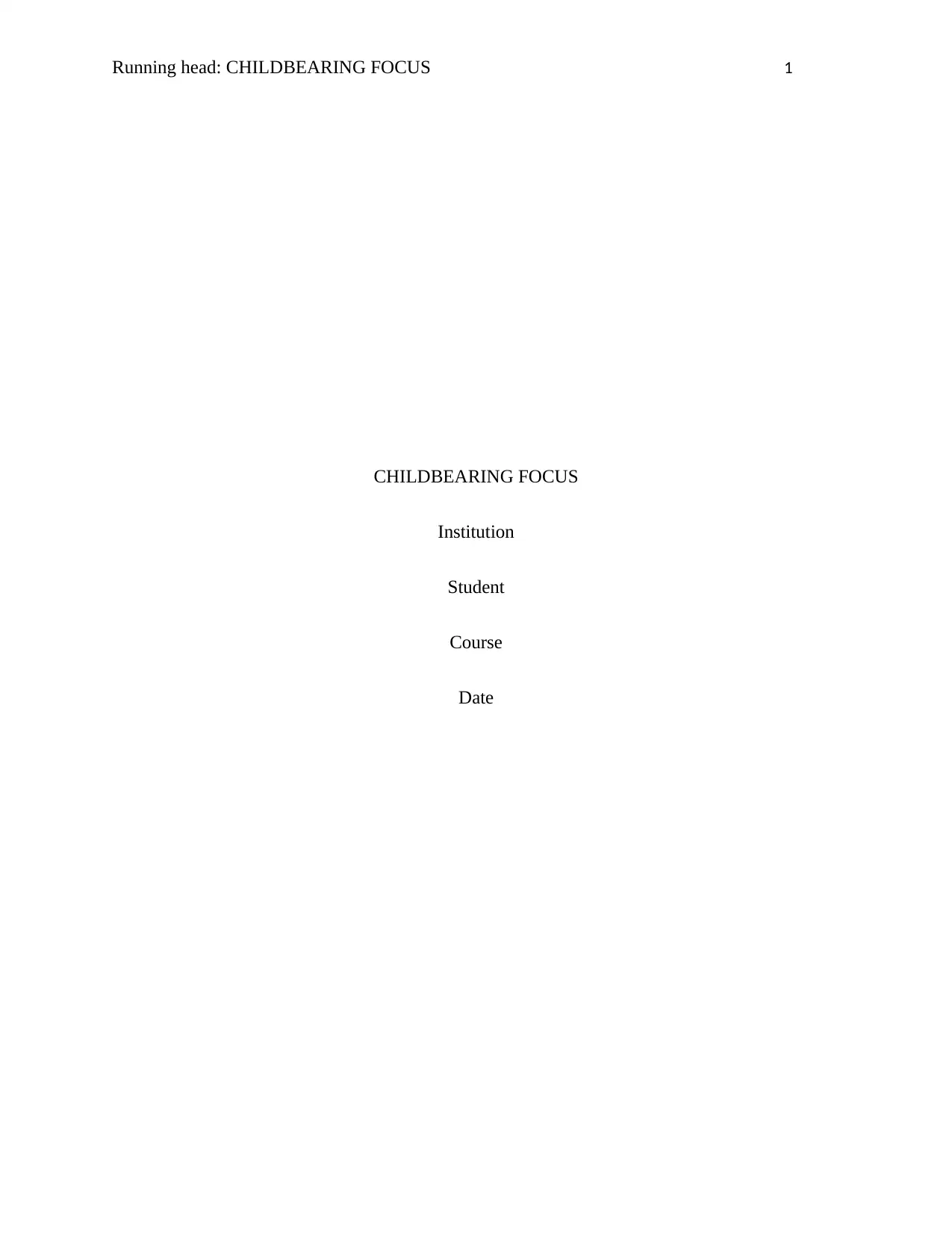
Running head: CHILDBEARING FOCUS 1
CHILDBEARING FOCUS
Institution
Student
Course
Date
CHILDBEARING FOCUS
Institution
Student
Course
Date
Paraphrase This Document
Need a fresh take? Get an instant paraphrase of this document with our AI Paraphraser
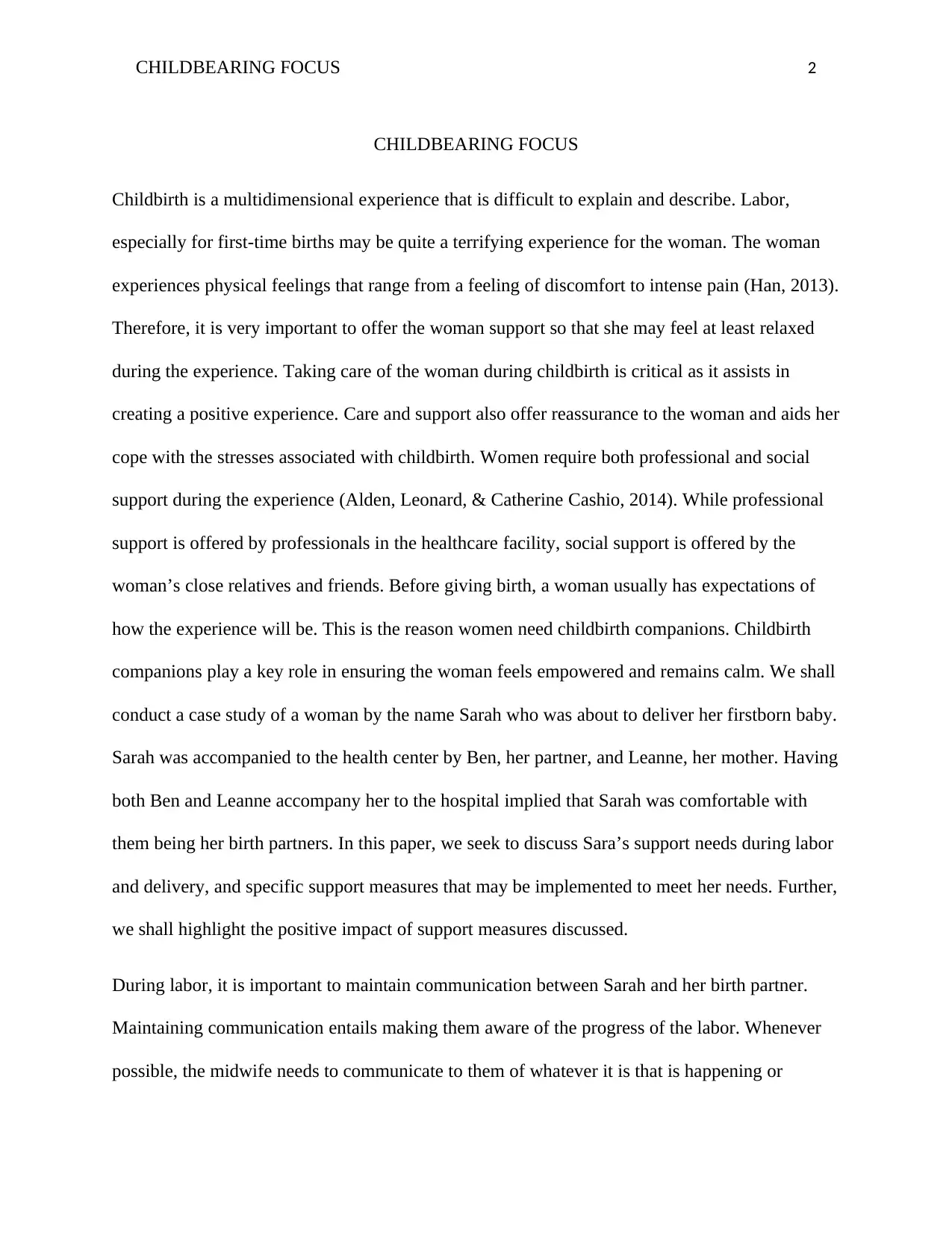
CHILDBEARING FOCUS 2
CHILDBEARING FOCUS
Childbirth is a multidimensional experience that is difficult to explain and describe. Labor,
especially for first-time births may be quite a terrifying experience for the woman. The woman
experiences physical feelings that range from a feeling of discomfort to intense pain (Han, 2013).
Therefore, it is very important to offer the woman support so that she may feel at least relaxed
during the experience. Taking care of the woman during childbirth is critical as it assists in
creating a positive experience. Care and support also offer reassurance to the woman and aids her
cope with the stresses associated with childbirth. Women require both professional and social
support during the experience (Alden, Leonard, & Catherine Cashio, 2014). While professional
support is offered by professionals in the healthcare facility, social support is offered by the
woman’s close relatives and friends. Before giving birth, a woman usually has expectations of
how the experience will be. This is the reason women need childbirth companions. Childbirth
companions play a key role in ensuring the woman feels empowered and remains calm. We shall
conduct a case study of a woman by the name Sarah who was about to deliver her firstborn baby.
Sarah was accompanied to the health center by Ben, her partner, and Leanne, her mother. Having
both Ben and Leanne accompany her to the hospital implied that Sarah was comfortable with
them being her birth partners. In this paper, we seek to discuss Sara’s support needs during labor
and delivery, and specific support measures that may be implemented to meet her needs. Further,
we shall highlight the positive impact of support measures discussed.
During labor, it is important to maintain communication between Sarah and her birth partner.
Maintaining communication entails making them aware of the progress of the labor. Whenever
possible, the midwife needs to communicate to them of whatever it is that is happening or
CHILDBEARING FOCUS
Childbirth is a multidimensional experience that is difficult to explain and describe. Labor,
especially for first-time births may be quite a terrifying experience for the woman. The woman
experiences physical feelings that range from a feeling of discomfort to intense pain (Han, 2013).
Therefore, it is very important to offer the woman support so that she may feel at least relaxed
during the experience. Taking care of the woman during childbirth is critical as it assists in
creating a positive experience. Care and support also offer reassurance to the woman and aids her
cope with the stresses associated with childbirth. Women require both professional and social
support during the experience (Alden, Leonard, & Catherine Cashio, 2014). While professional
support is offered by professionals in the healthcare facility, social support is offered by the
woman’s close relatives and friends. Before giving birth, a woman usually has expectations of
how the experience will be. This is the reason women need childbirth companions. Childbirth
companions play a key role in ensuring the woman feels empowered and remains calm. We shall
conduct a case study of a woman by the name Sarah who was about to deliver her firstborn baby.
Sarah was accompanied to the health center by Ben, her partner, and Leanne, her mother. Having
both Ben and Leanne accompany her to the hospital implied that Sarah was comfortable with
them being her birth partners. In this paper, we seek to discuss Sara’s support needs during labor
and delivery, and specific support measures that may be implemented to meet her needs. Further,
we shall highlight the positive impact of support measures discussed.
During labor, it is important to maintain communication between Sarah and her birth partner.
Maintaining communication entails making them aware of the progress of the labor. Whenever
possible, the midwife needs to communicate to them of whatever it is that is happening or
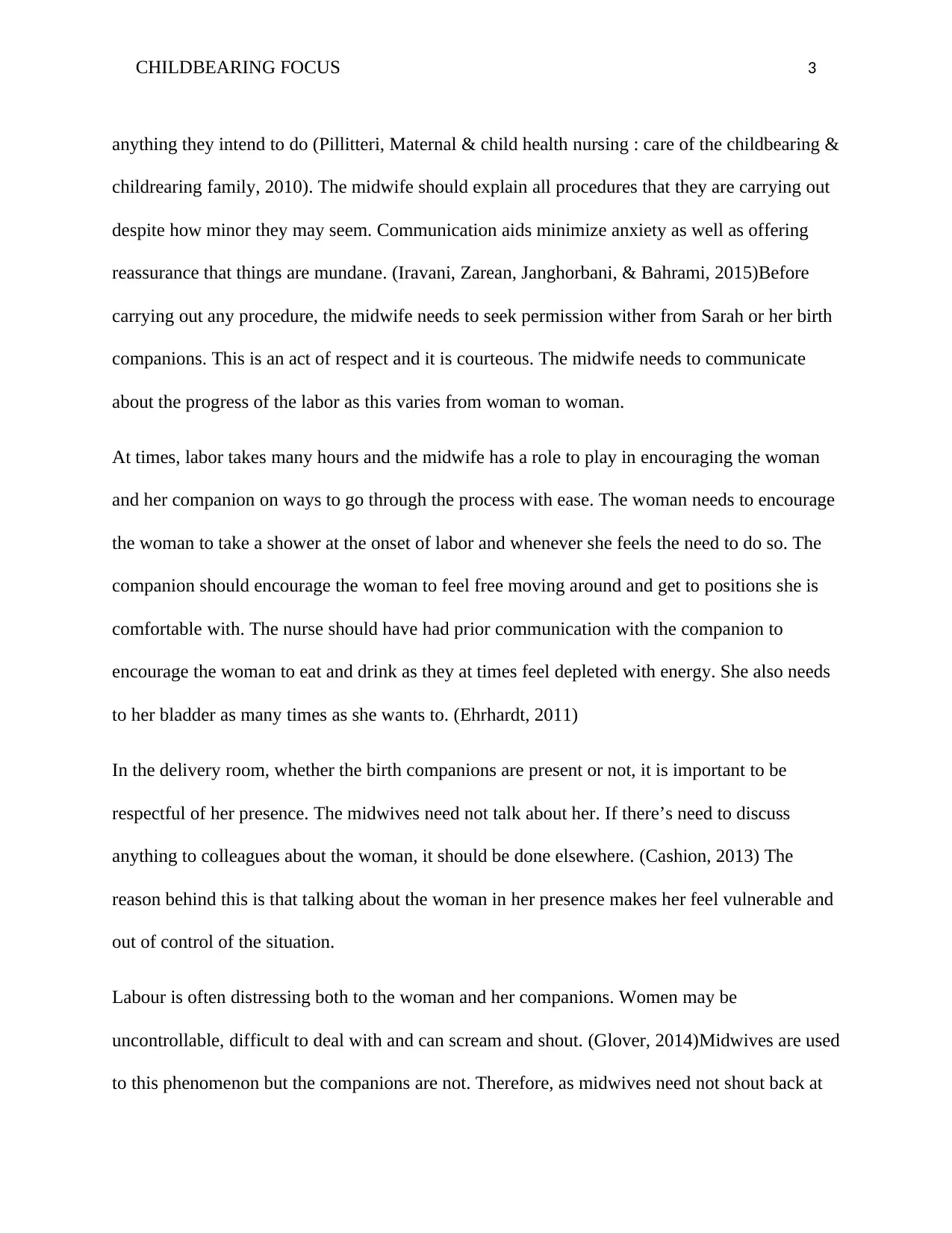
CHILDBEARING FOCUS 3
anything they intend to do (Pillitteri, Maternal & child health nursing : care of the childbearing &
childrearing family, 2010). The midwife should explain all procedures that they are carrying out
despite how minor they may seem. Communication aids minimize anxiety as well as offering
reassurance that things are mundane. (Iravani, Zarean, Janghorbani, & Bahrami, 2015)Before
carrying out any procedure, the midwife needs to seek permission wither from Sarah or her birth
companions. This is an act of respect and it is courteous. The midwife needs to communicate
about the progress of the labor as this varies from woman to woman.
At times, labor takes many hours and the midwife has a role to play in encouraging the woman
and her companion on ways to go through the process with ease. The woman needs to encourage
the woman to take a shower at the onset of labor and whenever she feels the need to do so. The
companion should encourage the woman to feel free moving around and get to positions she is
comfortable with. The nurse should have had prior communication with the companion to
encourage the woman to eat and drink as they at times feel depleted with energy. She also needs
to her bladder as many times as she wants to. (Ehrhardt, 2011)
In the delivery room, whether the birth companions are present or not, it is important to be
respectful of her presence. The midwives need not talk about her. If there’s need to discuss
anything to colleagues about the woman, it should be done elsewhere. (Cashion, 2013) The
reason behind this is that talking about the woman in her presence makes her feel vulnerable and
out of control of the situation.
Labour is often distressing both to the woman and her companions. Women may be
uncontrollable, difficult to deal with and can scream and shout. (Glover, 2014)Midwives are used
to this phenomenon but the companions are not. Therefore, as midwives need not shout back at
anything they intend to do (Pillitteri, Maternal & child health nursing : care of the childbearing &
childrearing family, 2010). The midwife should explain all procedures that they are carrying out
despite how minor they may seem. Communication aids minimize anxiety as well as offering
reassurance that things are mundane. (Iravani, Zarean, Janghorbani, & Bahrami, 2015)Before
carrying out any procedure, the midwife needs to seek permission wither from Sarah or her birth
companions. This is an act of respect and it is courteous. The midwife needs to communicate
about the progress of the labor as this varies from woman to woman.
At times, labor takes many hours and the midwife has a role to play in encouraging the woman
and her companion on ways to go through the process with ease. The woman needs to encourage
the woman to take a shower at the onset of labor and whenever she feels the need to do so. The
companion should encourage the woman to feel free moving around and get to positions she is
comfortable with. The nurse should have had prior communication with the companion to
encourage the woman to eat and drink as they at times feel depleted with energy. She also needs
to her bladder as many times as she wants to. (Ehrhardt, 2011)
In the delivery room, whether the birth companions are present or not, it is important to be
respectful of her presence. The midwives need not talk about her. If there’s need to discuss
anything to colleagues about the woman, it should be done elsewhere. (Cashion, 2013) The
reason behind this is that talking about the woman in her presence makes her feel vulnerable and
out of control of the situation.
Labour is often distressing both to the woman and her companions. Women may be
uncontrollable, difficult to deal with and can scream and shout. (Glover, 2014)Midwives are used
to this phenomenon but the companions are not. Therefore, as midwives need not shout back at
⊘ This is a preview!⊘
Do you want full access?
Subscribe today to unlock all pages.

Trusted by 1+ million students worldwide
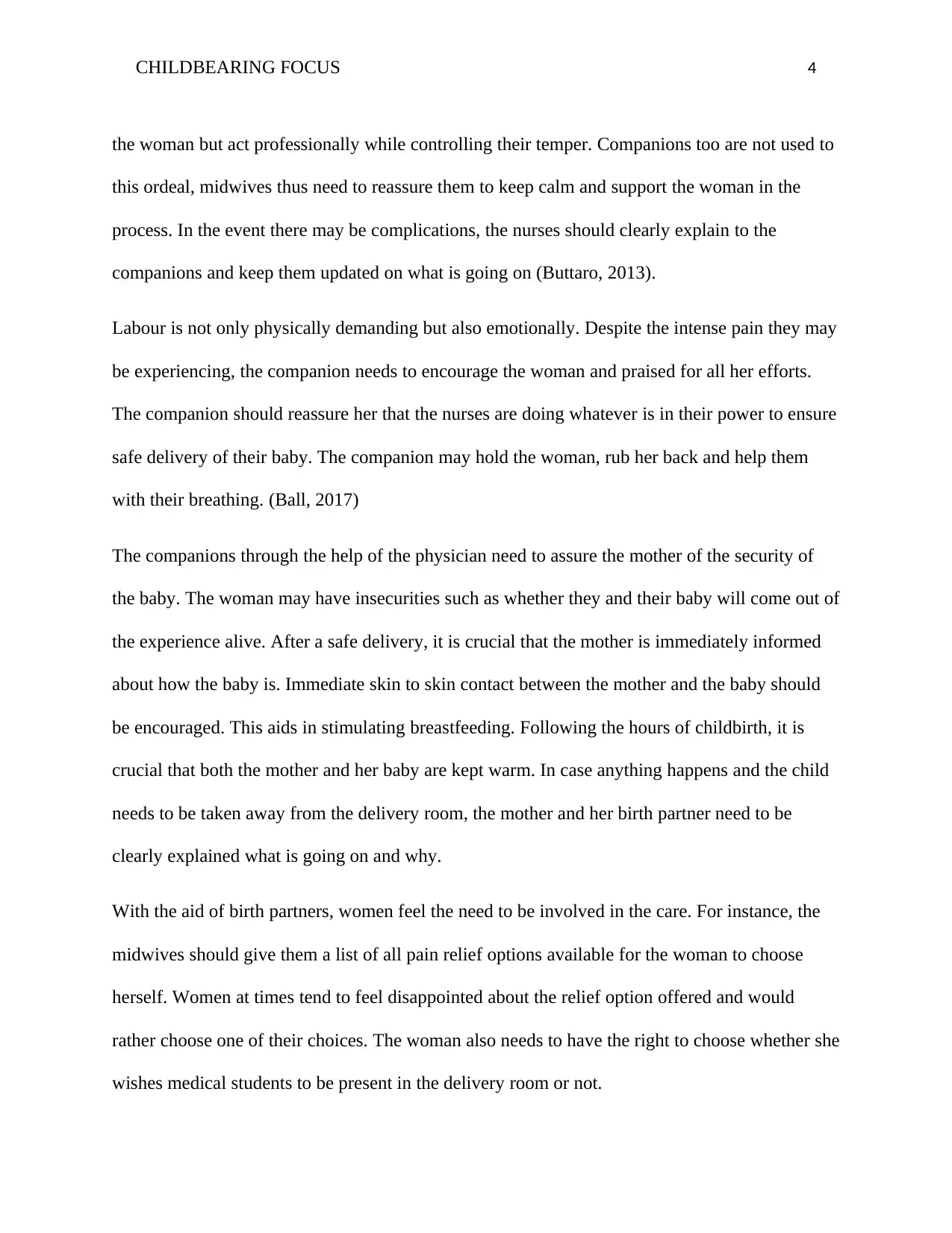
CHILDBEARING FOCUS 4
the woman but act professionally while controlling their temper. Companions too are not used to
this ordeal, midwives thus need to reassure them to keep calm and support the woman in the
process. In the event there may be complications, the nurses should clearly explain to the
companions and keep them updated on what is going on (Buttaro, 2013).
Labour is not only physically demanding but also emotionally. Despite the intense pain they may
be experiencing, the companion needs to encourage the woman and praised for all her efforts.
The companion should reassure her that the nurses are doing whatever is in their power to ensure
safe delivery of their baby. The companion may hold the woman, rub her back and help them
with their breathing. (Ball, 2017)
The companions through the help of the physician need to assure the mother of the security of
the baby. The woman may have insecurities such as whether they and their baby will come out of
the experience alive. After a safe delivery, it is crucial that the mother is immediately informed
about how the baby is. Immediate skin to skin contact between the mother and the baby should
be encouraged. This aids in stimulating breastfeeding. Following the hours of childbirth, it is
crucial that both the mother and her baby are kept warm. In case anything happens and the child
needs to be taken away from the delivery room, the mother and her birth partner need to be
clearly explained what is going on and why.
With the aid of birth partners, women feel the need to be involved in the care. For instance, the
midwives should give them a list of all pain relief options available for the woman to choose
herself. Women at times tend to feel disappointed about the relief option offered and would
rather choose one of their choices. The woman also needs to have the right to choose whether she
wishes medical students to be present in the delivery room or not.
the woman but act professionally while controlling their temper. Companions too are not used to
this ordeal, midwives thus need to reassure them to keep calm and support the woman in the
process. In the event there may be complications, the nurses should clearly explain to the
companions and keep them updated on what is going on (Buttaro, 2013).
Labour is not only physically demanding but also emotionally. Despite the intense pain they may
be experiencing, the companion needs to encourage the woman and praised for all her efforts.
The companion should reassure her that the nurses are doing whatever is in their power to ensure
safe delivery of their baby. The companion may hold the woman, rub her back and help them
with their breathing. (Ball, 2017)
The companions through the help of the physician need to assure the mother of the security of
the baby. The woman may have insecurities such as whether they and their baby will come out of
the experience alive. After a safe delivery, it is crucial that the mother is immediately informed
about how the baby is. Immediate skin to skin contact between the mother and the baby should
be encouraged. This aids in stimulating breastfeeding. Following the hours of childbirth, it is
crucial that both the mother and her baby are kept warm. In case anything happens and the child
needs to be taken away from the delivery room, the mother and her birth partner need to be
clearly explained what is going on and why.
With the aid of birth partners, women feel the need to be involved in the care. For instance, the
midwives should give them a list of all pain relief options available for the woman to choose
herself. Women at times tend to feel disappointed about the relief option offered and would
rather choose one of their choices. The woman also needs to have the right to choose whether she
wishes medical students to be present in the delivery room or not.
Paraphrase This Document
Need a fresh take? Get an instant paraphrase of this document with our AI Paraphraser
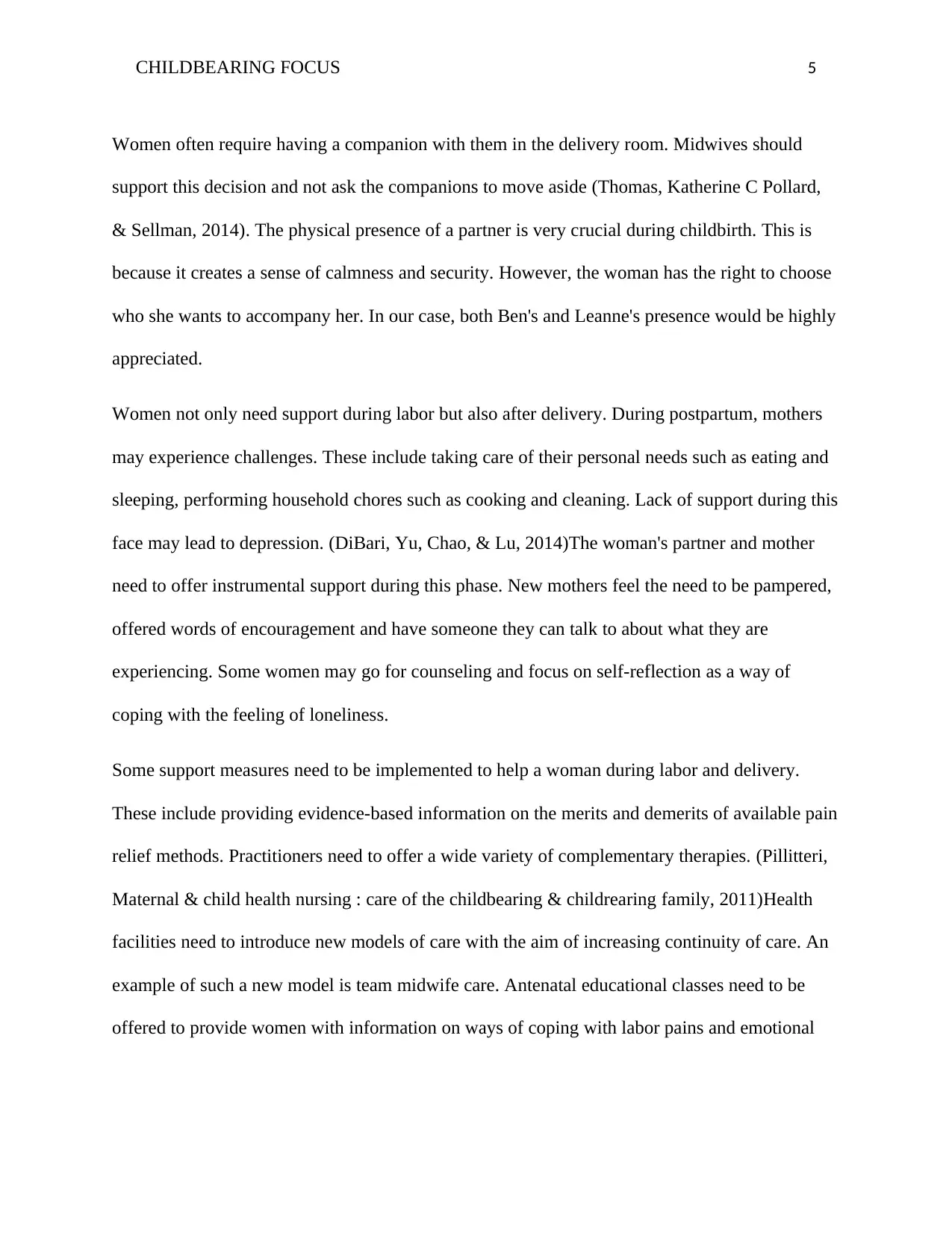
CHILDBEARING FOCUS 5
Women often require having a companion with them in the delivery room. Midwives should
support this decision and not ask the companions to move aside (Thomas, Katherine C Pollard,
& Sellman, 2014). The physical presence of a partner is very crucial during childbirth. This is
because it creates a sense of calmness and security. However, the woman has the right to choose
who she wants to accompany her. In our case, both Ben's and Leanne's presence would be highly
appreciated.
Women not only need support during labor but also after delivery. During postpartum, mothers
may experience challenges. These include taking care of their personal needs such as eating and
sleeping, performing household chores such as cooking and cleaning. Lack of support during this
face may lead to depression. (DiBari, Yu, Chao, & Lu, 2014)The woman's partner and mother
need to offer instrumental support during this phase. New mothers feel the need to be pampered,
offered words of encouragement and have someone they can talk to about what they are
experiencing. Some women may go for counseling and focus on self-reflection as a way of
coping with the feeling of loneliness.
Some support measures need to be implemented to help a woman during labor and delivery.
These include providing evidence-based information on the merits and demerits of available pain
relief methods. Practitioners need to offer a wide variety of complementary therapies. (Pillitteri,
Maternal & child health nursing : care of the childbearing & childrearing family, 2011)Health
facilities need to introduce new models of care with the aim of increasing continuity of care. An
example of such a new model is team midwife care. Antenatal educational classes need to be
offered to provide women with information on ways of coping with labor pains and emotional
Women often require having a companion with them in the delivery room. Midwives should
support this decision and not ask the companions to move aside (Thomas, Katherine C Pollard,
& Sellman, 2014). The physical presence of a partner is very crucial during childbirth. This is
because it creates a sense of calmness and security. However, the woman has the right to choose
who she wants to accompany her. In our case, both Ben's and Leanne's presence would be highly
appreciated.
Women not only need support during labor but also after delivery. During postpartum, mothers
may experience challenges. These include taking care of their personal needs such as eating and
sleeping, performing household chores such as cooking and cleaning. Lack of support during this
face may lead to depression. (DiBari, Yu, Chao, & Lu, 2014)The woman's partner and mother
need to offer instrumental support during this phase. New mothers feel the need to be pampered,
offered words of encouragement and have someone they can talk to about what they are
experiencing. Some women may go for counseling and focus on self-reflection as a way of
coping with the feeling of loneliness.
Some support measures need to be implemented to help a woman during labor and delivery.
These include providing evidence-based information on the merits and demerits of available pain
relief methods. Practitioners need to offer a wide variety of complementary therapies. (Pillitteri,
Maternal & child health nursing : care of the childbearing & childrearing family, 2011)Health
facilities need to introduce new models of care with the aim of increasing continuity of care. An
example of such a new model is team midwife care. Antenatal educational classes need to be
offered to provide women with information on ways of coping with labor pains and emotional
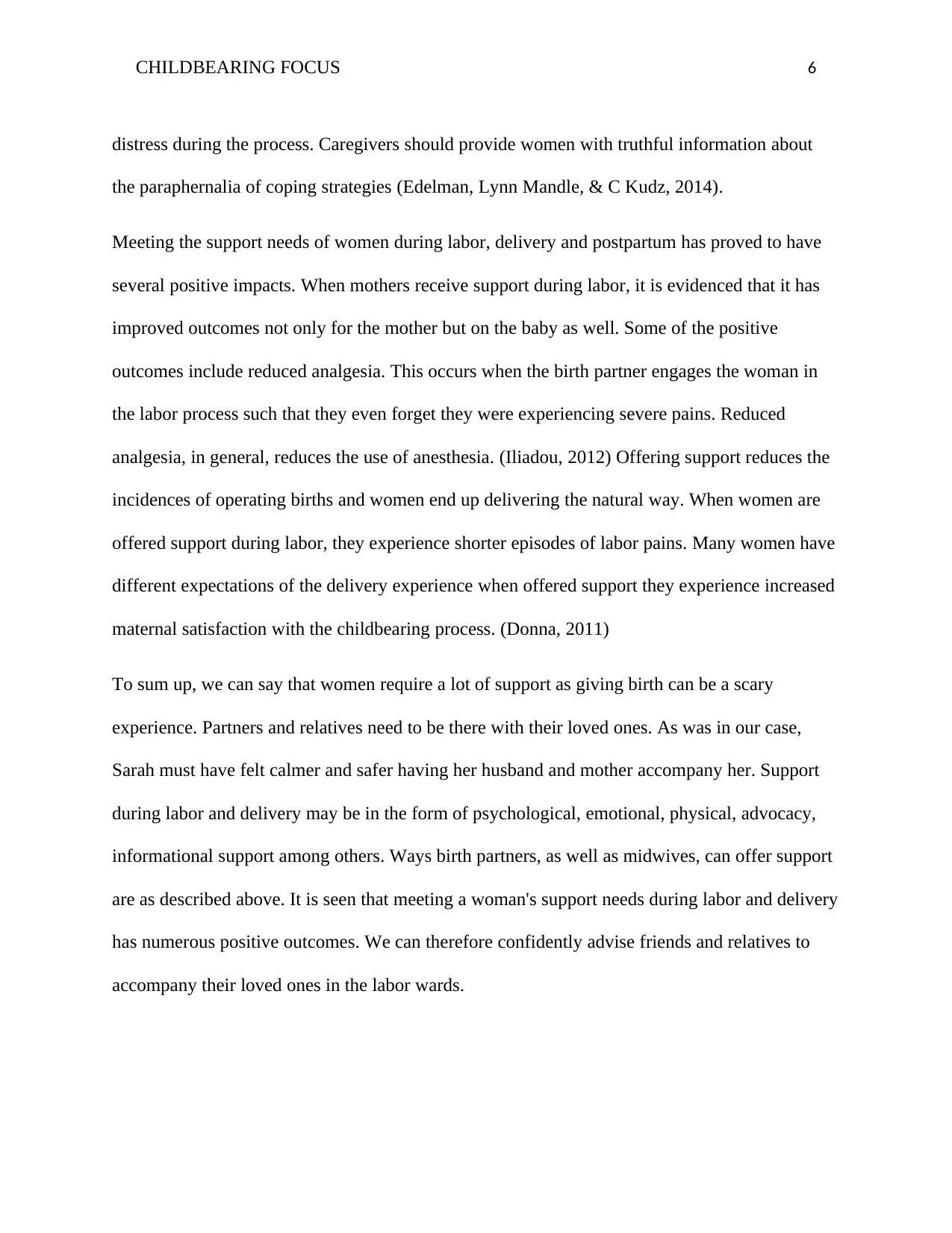
CHILDBEARING FOCUS 6
distress during the process. Caregivers should provide women with truthful information about
the paraphernalia of coping strategies (Edelman, Lynn Mandle, & C Kudz, 2014).
Meeting the support needs of women during labor, delivery and postpartum has proved to have
several positive impacts. When mothers receive support during labor, it is evidenced that it has
improved outcomes not only for the mother but on the baby as well. Some of the positive
outcomes include reduced analgesia. This occurs when the birth partner engages the woman in
the labor process such that they even forget they were experiencing severe pains. Reduced
analgesia, in general, reduces the use of anesthesia. (Iliadou, 2012) Offering support reduces the
incidences of operating births and women end up delivering the natural way. When women are
offered support during labor, they experience shorter episodes of labor pains. Many women have
different expectations of the delivery experience when offered support they experience increased
maternal satisfaction with the childbearing process. (Donna, 2011)
To sum up, we can say that women require a lot of support as giving birth can be a scary
experience. Partners and relatives need to be there with their loved ones. As was in our case,
Sarah must have felt calmer and safer having her husband and mother accompany her. Support
during labor and delivery may be in the form of psychological, emotional, physical, advocacy,
informational support among others. Ways birth partners, as well as midwives, can offer support
are as described above. It is seen that meeting a woman's support needs during labor and delivery
has numerous positive outcomes. We can therefore confidently advise friends and relatives to
accompany their loved ones in the labor wards.
distress during the process. Caregivers should provide women with truthful information about
the paraphernalia of coping strategies (Edelman, Lynn Mandle, & C Kudz, 2014).
Meeting the support needs of women during labor, delivery and postpartum has proved to have
several positive impacts. When mothers receive support during labor, it is evidenced that it has
improved outcomes not only for the mother but on the baby as well. Some of the positive
outcomes include reduced analgesia. This occurs when the birth partner engages the woman in
the labor process such that they even forget they were experiencing severe pains. Reduced
analgesia, in general, reduces the use of anesthesia. (Iliadou, 2012) Offering support reduces the
incidences of operating births and women end up delivering the natural way. When women are
offered support during labor, they experience shorter episodes of labor pains. Many women have
different expectations of the delivery experience when offered support they experience increased
maternal satisfaction with the childbearing process. (Donna, 2011)
To sum up, we can say that women require a lot of support as giving birth can be a scary
experience. Partners and relatives need to be there with their loved ones. As was in our case,
Sarah must have felt calmer and safer having her husband and mother accompany her. Support
during labor and delivery may be in the form of psychological, emotional, physical, advocacy,
informational support among others. Ways birth partners, as well as midwives, can offer support
are as described above. It is seen that meeting a woman's support needs during labor and delivery
has numerous positive outcomes. We can therefore confidently advise friends and relatives to
accompany their loved ones in the labor wards.
⊘ This is a preview!⊘
Do you want full access?
Subscribe today to unlock all pages.

Trusted by 1+ million students worldwide
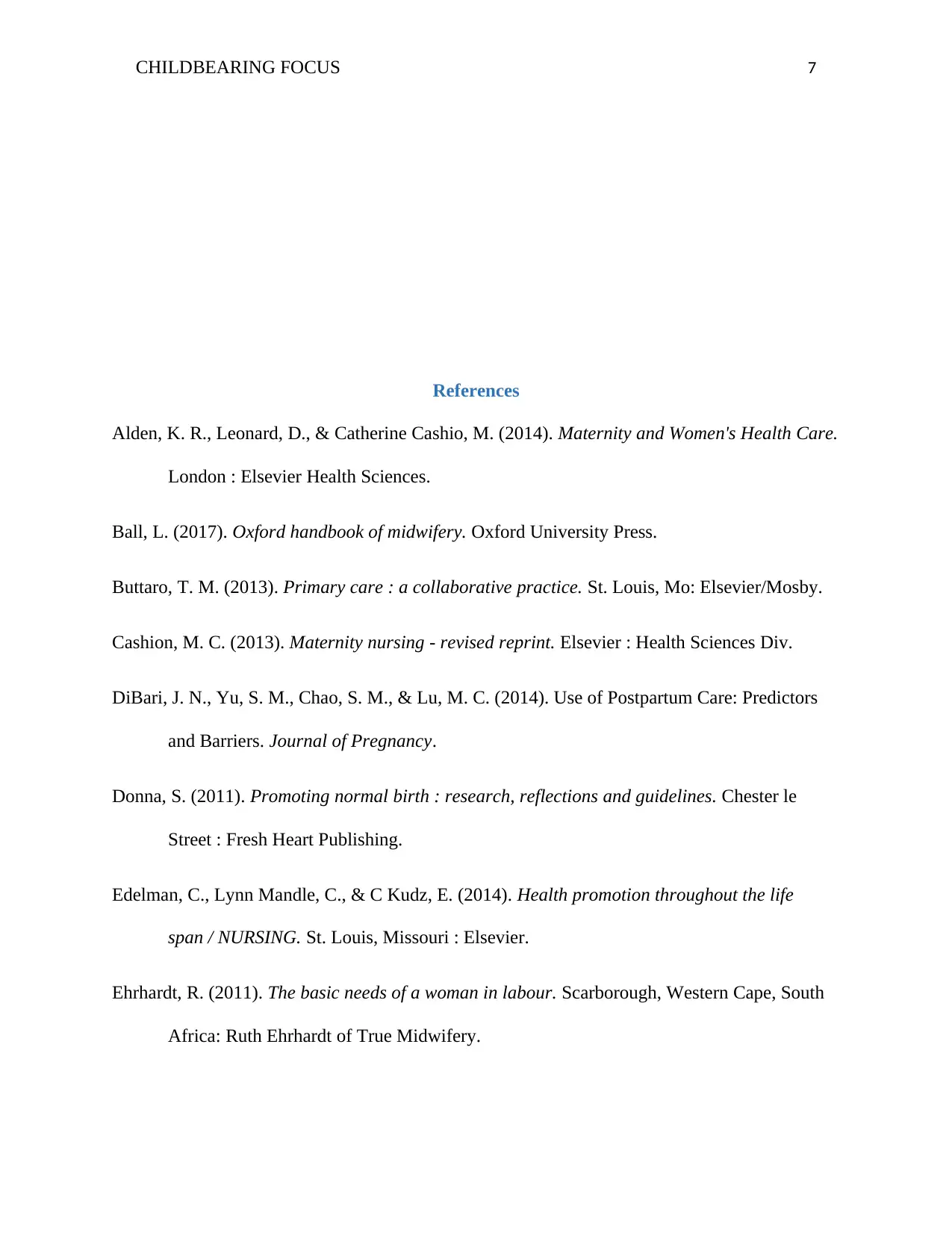
CHILDBEARING FOCUS 7
References
Alden, K. R., Leonard, D., & Catherine Cashio, M. (2014). Maternity and Women's Health Care.
London : Elsevier Health Sciences.
Ball, L. (2017). Oxford handbook of midwifery. Oxford University Press.
Buttaro, T. M. (2013). Primary care : a collaborative practice. St. Louis, Mo: Elsevier/Mosby.
Cashion, M. C. (2013). Maternity nursing - revised reprint. Elsevier : Health Sciences Div.
DiBari, J. N., Yu, S. M., Chao, S. M., & Lu, M. C. (2014). Use of Postpartum Care: Predictors
and Barriers. Journal of Pregnancy.
Donna, S. (2011). Promoting normal birth : research, reflections and guidelines. Chester le
Street : Fresh Heart Publishing.
Edelman, C., Lynn Mandle, C., & C Kudz, E. (2014). Health promotion throughout the life
span / NURSING. St. Louis, Missouri : Elsevier.
Ehrhardt, R. (2011). The basic needs of a woman in labour. Scarborough, Western Cape, South
Africa: Ruth Ehrhardt of True Midwifery.
References
Alden, K. R., Leonard, D., & Catherine Cashio, M. (2014). Maternity and Women's Health Care.
London : Elsevier Health Sciences.
Ball, L. (2017). Oxford handbook of midwifery. Oxford University Press.
Buttaro, T. M. (2013). Primary care : a collaborative practice. St. Louis, Mo: Elsevier/Mosby.
Cashion, M. C. (2013). Maternity nursing - revised reprint. Elsevier : Health Sciences Div.
DiBari, J. N., Yu, S. M., Chao, S. M., & Lu, M. C. (2014). Use of Postpartum Care: Predictors
and Barriers. Journal of Pregnancy.
Donna, S. (2011). Promoting normal birth : research, reflections and guidelines. Chester le
Street : Fresh Heart Publishing.
Edelman, C., Lynn Mandle, C., & C Kudz, E. (2014). Health promotion throughout the life
span / NURSING. St. Louis, Missouri : Elsevier.
Ehrhardt, R. (2011). The basic needs of a woman in labour. Scarborough, Western Cape, South
Africa: Ruth Ehrhardt of True Midwifery.
Paraphrase This Document
Need a fresh take? Get an instant paraphrase of this document with our AI Paraphraser
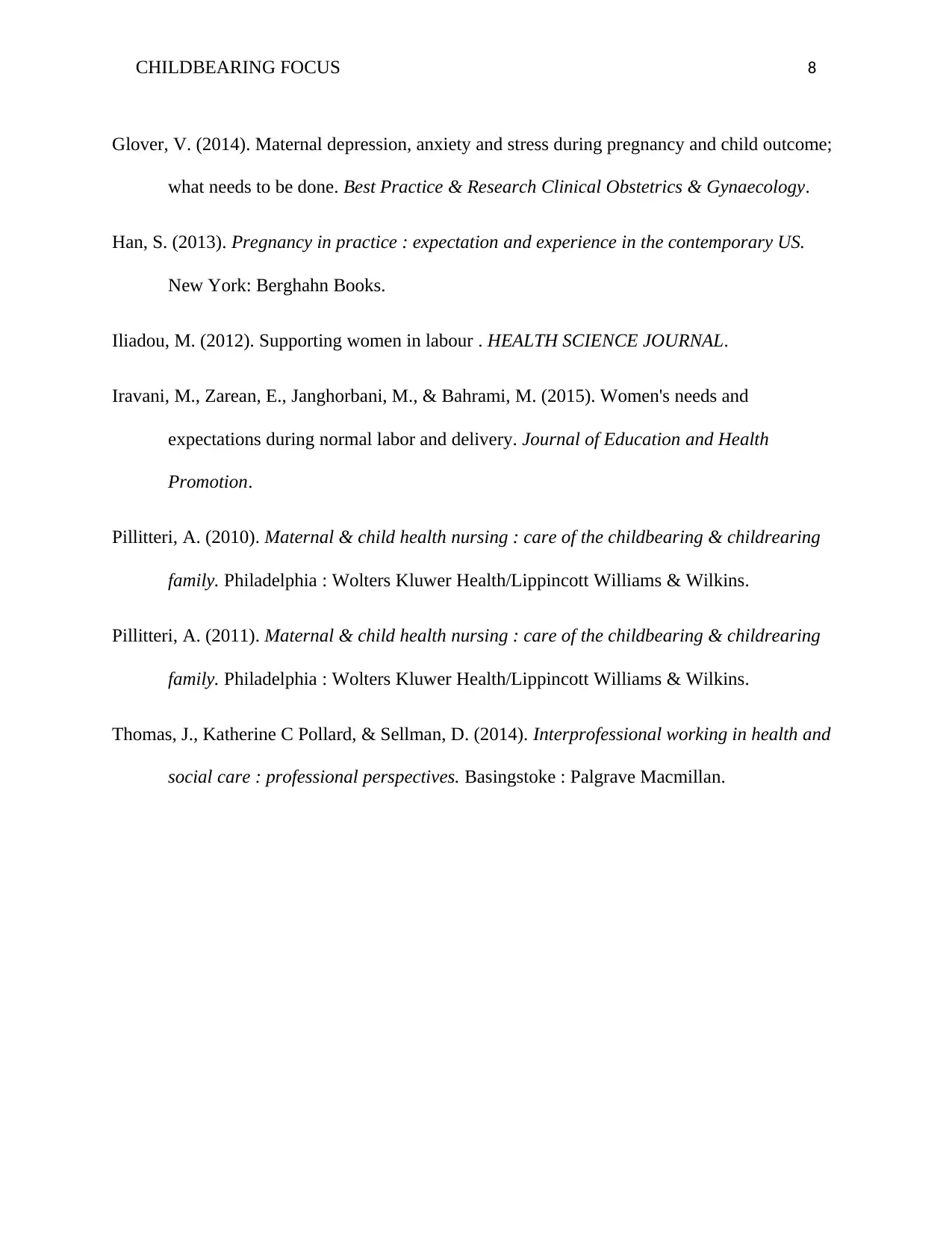
CHILDBEARING FOCUS 8
Glover, V. (2014). Maternal depression, anxiety and stress during pregnancy and child outcome;
what needs to be done. Best Practice & Research Clinical Obstetrics & Gynaecology.
Han, S. (2013). Pregnancy in practice : expectation and experience in the contemporary US.
New York: Berghahn Books.
Iliadou, M. (2012). Supporting women in labour . HEALTH SCIENCE JOURNAL.
Iravani, M., Zarean, E., Janghorbani, M., & Bahrami, M. (2015). Women's needs and
expectations during normal labor and delivery. Journal of Education and Health
Promotion.
Pillitteri, A. (2010). Maternal & child health nursing : care of the childbearing & childrearing
family. Philadelphia : Wolters Kluwer Health/Lippincott Williams & Wilkins.
Pillitteri, A. (2011). Maternal & child health nursing : care of the childbearing & childrearing
family. Philadelphia : Wolters Kluwer Health/Lippincott Williams & Wilkins.
Thomas, J., Katherine C Pollard, & Sellman, D. (2014). Interprofessional working in health and
social care : professional perspectives. Basingstoke : Palgrave Macmillan.
Glover, V. (2014). Maternal depression, anxiety and stress during pregnancy and child outcome;
what needs to be done. Best Practice & Research Clinical Obstetrics & Gynaecology.
Han, S. (2013). Pregnancy in practice : expectation and experience in the contemporary US.
New York: Berghahn Books.
Iliadou, M. (2012). Supporting women in labour . HEALTH SCIENCE JOURNAL.
Iravani, M., Zarean, E., Janghorbani, M., & Bahrami, M. (2015). Women's needs and
expectations during normal labor and delivery. Journal of Education and Health
Promotion.
Pillitteri, A. (2010). Maternal & child health nursing : care of the childbearing & childrearing
family. Philadelphia : Wolters Kluwer Health/Lippincott Williams & Wilkins.
Pillitteri, A. (2011). Maternal & child health nursing : care of the childbearing & childrearing
family. Philadelphia : Wolters Kluwer Health/Lippincott Williams & Wilkins.
Thomas, J., Katherine C Pollard, & Sellman, D. (2014). Interprofessional working in health and
social care : professional perspectives. Basingstoke : Palgrave Macmillan.
1 out of 8
Related Documents
Your All-in-One AI-Powered Toolkit for Academic Success.
+13062052269
info@desklib.com
Available 24*7 on WhatsApp / Email
![[object Object]](/_next/static/media/star-bottom.7253800d.svg)
Unlock your academic potential
Copyright © 2020–2025 A2Z Services. All Rights Reserved. Developed and managed by ZUCOL.



